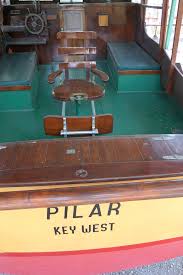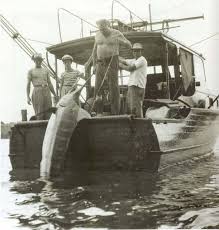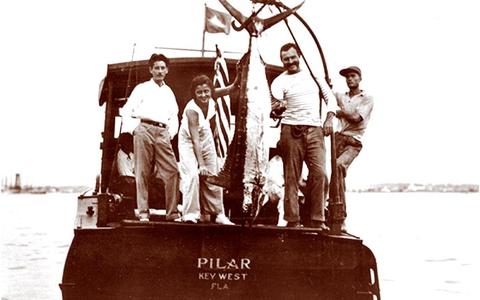
HEMINGWAY REGRESA A CUBA CON LA PASION DE SU VIDA “EL PILAR”. VIDEOS.
En 1934, nada más regresar de un safari por África y con los algo más de 3.000 dólares que había recibido de adelanto por unos relatos breves, Ernest Hemingway se dirigió a un astillero de Coney Island y se hizo con un elegante yate deportivo que bautizaría con el nombre de Pilar.
“El Pilar” se refiere al barco de pesca de 38 pies que fue fundamental en su vida en Cuba e inspiró su novela El viejo y el mar.
El 19 de julio de ese año, Hemingway ponía rumbo a Cuba, isla en la que acabaría instalándose unos años más tarde, a bordo de su flamante barco, especialmente equipado para una de sus aficiones favoritas, la pesca deportiva.
Comenzaba un romance entre el escritor, una isla y un barco que se acabó convirtiendo en inspiración literaria y en su único amor y refugio constantes hasta su muerte, en 1961. Casi 81 años después de ese primer viaje en el Pilar, otros Hemingway -sus nietos John y Patrick- y en otros barcos, han tomado el mismo rumbo desde el mismo puerto de partida, Key West, y con el mismo destino, Cuba. Es este un viaje “histórico y simbólico”, dijo John Hemingway a este periódico. Y con una gran carga de recuerdos y sobre todo esperanza, subrayó, en la nueva era que comenzó entre Estados Unidos y la isla con el anuncio de la normalización de relaciones tras más de medio siglo de antagonismo, el pasado 17 de diciembre.
El periplo, que comenzó el viernes con la partida de la flotilla estadounidense, continuará el lunes con la participación de los nietos del escritor, junto con otro medio centenar de pescadores aficionados norteamericanos, en el Torneo de la Pesca de Aguja “Ernest Hemingway”, que cumple 65 años. A bordo de su amado Pilar, “Papá Hemingway” ganó tres veces seguidas, de 1953 a 1955, el torneo que acabó recibiendo su nombre y en el que estuvo presente, por última vez, en 1960, momento en el que coincidió con Fidel Castro.
Hemingway
Hace ya algunos años, algunos estadounidenses participaron en el torneo cubano -uno de los más antiguos del mundo, según sus organizadores- aunque tuvieron que volar primero a la isla para ello. Han tenido que pasar décadas, y un cambio radical en la política de EE UU hacia Cuba, para que pudieran zarpar -al menos de forma legal, subraya John Hemingway- en sus propios barcos hacia la isla. Un objetivo que ha costado meses de trabajo y burocracia para obtener los permisos del Gobierno estadounidense. Dado que el embargo sigue en pie, se requiere de una licencia especial del Departamento de Comercio tan solo para que un barco parta de EE UU hacia Cuba y pueda regresar. Y otra del Departamento del Tesoro para transportar a personas.
Pero el esfuerzo ha merecido la pena, sostuvo Jeffrey Boutwell, del Latin American Working Group Education Fund, la organización que está detrás de este viaje. “No hay otra persona que simbolice la amistad entre Cuba y EE UU de la forma en que lo hace Ernest Hemingway”, recordó.
CUBA EEUU
La primera visita de los nietos de Hemingway a Cuba, en septiembre del 2014, sirvió para conmemorar el 60 aniversario del Nobel de Literatura que recibió su abuelo. Además, promovieron el acercamiento entre los pueblos y abogaron por esfuerzos conservacionistas bilaterales con los que esperaban también tender puentes entre Cuba y EE UU. Ocho meses más tarde, y con el 17 de diciembre de por medio, sus deseos empiezan a cumplirse. Falta aún sin embargo la libertad para viajar a Cuba de la que disfrutó Hemingway, recuerdan tanto su nieto como Boutwell. Por ello, este viaje también adquiere ahora un tono reivindicativo que están seguros habría aplaudido el autor de “El viejo y el mar”.
“No solo lo habría aprobado, estoy seguro de que se habría sentido muy indignado ante la idea de que los estadounidenses tuvieran prohibido viajar libremente a Cuba”, afirmó Boutwell. “No importan cuáles pudieran ser las diferencias políticas o los diferentes gobiernos, Hemingway se habría sentido totalmente horrorizado por que el Gobierno estadounidense restringiera a sus ciudadanos los viajes al extranjero”.

HEMINGWAY RETURNS TO CUBA WITH HIS LIFE’S PASSION, “EL PILAR.” VIDEOS.
In 1934, having just returned from an African safari and with the slightly more than $3,000 he had received as an advance for some short stories, Ernest Hemingway went to a shipyard in Coney Island and acquired an elegant sports yacht, which he christened Pilar.
“El Pilar” refers to the 38-foot fishing boat that was fundamental to his life in Cuba and inspired his novel The Old Man and the Sea.
On July 19 of that year, Hemingway set sail for Cuba, the island where he would eventually settle a few years later, aboard his brand-new boat, specially equipped for one of his favorite pastimes: sport fishing.
Thus began a romance between the writer, an island, and a boat that would become his literary inspiration and his one and only constant love and refuge until his death in 1961. Almost 81 years after that first voyage on the Pilar, other Hemingways—his grandsons John and Patrick—and other boats have set the same course from the same port of departure, Key West, and with the same destination, Cuba. This is a “historic and symbolic” journey, John Hemingway told this newspaper. And with a heavy burden of memories and, above all, hope, he emphasized, in the new era that began between the United States and the island with the announcement of the normalization of relations after more than half a century of antagonism, this past December 17th.
The journey, which began on Friday with the departure of the American flotilla, will continue on Monday with the participation of the writer’s grandsons, along with about fifty other American anglers, in the Ernest Hemingway Billfish Tournament, which is celebrating its 65th anniversary. Aboard his beloved Pilar, “Papa Hemingway” won the tournament that eventually bore his name three times in a row, from 1953 to 1955. He last attended in 1960, when he met Fidel Castro.

Hemingway
In recent years, some Americans have participated in the Cuban tournament—one of the oldest in the world, according to its organizers—though they first had to fly to the island. Decades and a radical shift in U.S. policy toward Cuba have been necessary for them to set sail—at least legally, John Hemingway emphasizes—on their own ships for the island. This goal has required months of work and bureaucratic hurdles to obtain the necessary permits from the U.S. government. Since the embargo remains in place, a special license from the Department of Commerce is required just for a ship to depart from the U.S. to Cuba and return. Another license from the Department of the Treasury is required to transport passengers.
But the effort has been worthwhile, said Jeffrey Boutwell of the Latin American Working Group Education Fund, the organization behind this trip. “There is no one else who symbolizes the friendship between Cuba and the US the way Ernest Hemingway does,” he noted.
CUBA-USA
The first visit of Hemingway’s grandchildren to Cuba, in September of last year, served to commemorate the 60th anniversary of their grandfather’s Nobel Prize in Literature. They also promoted closer ties between the two nations and advocated for bilateral conservation efforts, hoping to build bridges between Cuba and the US. Eight months later, and with December 17th in between, their wishes are beginning to come true. However, the freedom to travel to Cuba that Hemingway enjoyed is still lacking, both his grandson and Boutwell point out. Therefore, this trip also takes on a more assertive tone, one they are certain the author of “The Old Man and the Sea” would have applauded.
“Not only would he have approved, I’m sure he would have been outraged at the idea of Americans being prohibited from traveling freely to Cuba,” Boutwell said. “No matter what the political differences or different governments might be, Hemingway would have been absolutely horrified by the U.S. government restricting its citizens’ foreign travel.”


Agencies/ El Pais, Spain/ Silvia Ayuso/ Internet Photos/ www.thecubanhistory.com/ Arnoldo Varona.
THE CUBAN HISTORY, HOLLYWOOD.



